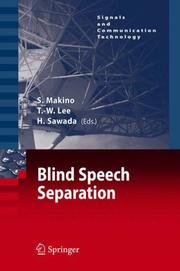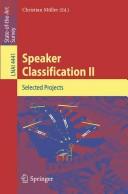| Listing 1 - 2 of 2 |
Sort by
|

ISBN: 1281070157 9786611070151 1402064799 1402064780 9048176514 Year: 2007 Publisher: Dordrecht : Springer Netherlands : Imprint: Springer,
Abstract | Keywords | Export | Availability | Bookmark
 Loading...
Loading...Choose an application
- Reference Manager
- EndNote
- RefWorks (Direct export to RefWorks)
This is the first book to provide a cutting edge reference to the fascinating topic of blind source separation (BSS) for convolved speech mixtures. Through contributions by the foremost experts on the subject, the book provides an up-to-date account of research findings, explains the underlying theory, and discusses potential applications. The individual chapters are designed to be tutorial in nature with specific emphasis on an in-depth treatment of state of the art techniques. Blind Speech Separation is divided into three parts: Part 1 presents overdetermined or critically determined BSS. Here the main technology is independent component analysis (ICA). ICA is a statistical method for extracting mutually independent sources from their mixtures. This approach utilizes spatial diversity to discriminate between desired and undesired components, i.e., it reduces the undesired components by forming a spatial null towards them. It is, in fact, a blind adaptive beamformer realized by unsupervised adaptive filtering. Part 2 addresses underdetermined BSS, where there are fewer microphones than source signals. Here, the sparseness of speech sources is very useful; we can utilize time-frequency diversity, where sources are active in different regions of the time-frequency plane. Part 3 presents monaural BSS where there is only one microphone. Here, we can separate a mixture by using the harmonicity and temporal structure of the sources. We can build a probabilistic framework by assuming a source model, and separate a mixture by maximizing the a posteriori probability of the sources.
Automatic speech recognition. --- Speech processing systems. --- Computational linguistics --- Electronic systems --- Information theory --- Modulation theory --- Oral communication --- Speech --- Telecommunication --- Singing voice synthesizers --- Mechanical speech recognizer --- Speech recognition, Automatic --- Pattern recognition systems --- Perceptrons --- Speech, Intelligibility of --- Speech perception --- Speech processing systems --- Telecommunication. --- Microwaves. --- Signal, Image and Speech Processing. --- Communications Engineering, Networks. --- Microwaves, RF and Optical Engineering. --- Hertzian waves --- Electric waves --- Electromagnetic waves --- Geomagnetic micropulsations --- Radio waves --- Shortwave radio --- Electric communication --- Mass communication --- Telecom --- Telecommunication industry --- Telecommunications --- Communication --- Telecommuting --- Signal processing. --- Image processing. --- Electrical engineering. --- Optical engineering. --- Mechanical engineering --- Electric engineering --- Engineering --- Pictorial data processing --- Picture processing --- Processing, Image --- Imaging systems --- Optical data processing --- Processing, Signal --- Information measurement --- Signal theory (Telecommunication)

ISBN: 9783540741862 3540741860 9783540741213 3540741216 354074200X 3540741224 Year: 2007 Publisher: Berlin, Germany ; New York, New York : Springer,
Abstract | Keywords | Export | Availability | Bookmark
 Loading...
Loading...Choose an application
- Reference Manager
- EndNote
- RefWorks (Direct export to RefWorks)
As well as conveying a message in words and sounds, the speech signal carries information about the speaker's own anatomy, physiology, linguistic experience and mental state. These speaker characteristics are found in speech at all levels of description: from the spectral information in the sounds to the choice of words and utterances themselves. This two volume set, LNAI 4343 and LNAI 4441, constitutes a state-of-the-art survey for the field of speaker classification. It approaches the following questions: What characteristics of the speaker become manifest in his or her voice and speaking behavior? Which of them can be inferred from analyzing the acoustic realizations? What can this information be used for? Which methods are the most suitable for diversified problems in this area of research? How should the quality of the results be evaluated? The 22 articles of the second volume comprise a number of selected self-contained papers on research projects in the field of speaker classification. These include among other things a report on a gender recognition system; a study on emotion recognition; a presentation of a text-dependent speaker verification system; an account of the analysis of both speaker and verbal content information - as well as studies on accent identification.
Speech processing systems. --- Speech perception. --- Voice --- Sociolinguistics. --- Traitement automatique de la parole --- Perception de la parole --- Voix --- Sociolinguistique --- Identification. --- Identification --- Mechanical Engineering --- Engineering & Applied Sciences --- Computer Science --- Mechanical Engineering - General --- Speech processing systems --- Speech perception --- Sociolinguistics --- Electrical Engineering --- Electrical & Computer Engineering --- Information Technology --- Artificial Intelligence --- Speech recognition --- Engineering. --- User interfaces (Computer systems). --- Artificial intelligence. --- Computational linguistics. --- Pattern recognition. --- Application software. --- Signal, Image and Speech Processing. --- Pattern Recognition. --- Computer Applications. --- Artificial Intelligence (incl. Robotics). --- Language Translation and Linguistics. --- User Interfaces and Human Computer Interaction. --- Computer science. --- Computer hardware. --- Image processing. --- Computer Science. --- Computer Hardware. --- Image Processing and Computer Vision. --- Application computer programs --- Application computer software --- Applications software --- Apps (Computer software) --- Computer software --- Design perception --- Pattern recognition --- Form perception --- Perception --- Figure-ground perception --- Automatic language processing --- Language and languages --- Language data processing --- Linguistics --- Natural language processing (Linguistics) --- Applied linguistics --- Cross-language information retrieval --- Mathematical linguistics --- Multilingual computing --- AI (Artificial intelligence) --- Artificial thinking --- Electronic brains --- Intellectronics --- Intelligence, Artificial --- Intelligent machines --- Machine intelligence --- Thinking, Artificial --- Bionics --- Cognitive science --- Digital computer simulation --- Electronic data processing --- Logic machines --- Machine theory --- Self-organizing systems --- Simulation methods --- Fifth generation computers --- Neural computers --- Interfaces, User (Computer systems) --- Human-machine systems --- Human-computer interaction --- Construction --- Industrial arts --- Technology --- Data processing --- Pictorial data processing --- Picture processing --- Processing, Image --- Imaging systems --- Optical data processing --- Informatics --- Science --- Auditory perception --- Psycholinguistics --- Speech --- Computational linguistics --- Electronic systems --- Information theory --- Modulation theory --- Oral communication --- Telecommunication --- Singing voice synthesizers --- Natural language processing (Computer science). --- Optical pattern recognition. --- Computer vision. --- Artificial Intelligence. --- Natural Language Processing (NLP). --- NLP (Computer science) --- Artificial intelligence --- Semantic computing --- Pattern perception --- Perceptrons --- Visual discrimination --- Machine vision --- Vision, Computer --- Image processing --- Pattern recognition systems --- Signal processing. --- Optical data processing. --- Processing, Signal --- Information measurement --- Signal theory (Telecommunication) --- Optical computing --- Visual data processing --- Integrated optics --- Photonics --- Computers --- Optical equipment --- Automatic speech recognition. --- Mechanical speech recognizer --- Speech recognition, Automatic --- Speech, Intelligibility of --- Speaking --- Human sounds --- Music --- Throat --- Diaphragm --- Elocution --- Larynx --- Physiological aspects
| Listing 1 - 2 of 2 |
Sort by
|

 Search
Search Feedback
Feedback About
About Help
Help News
News